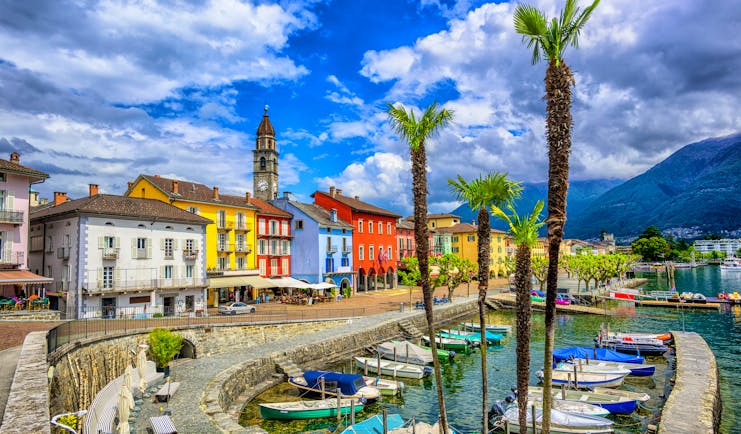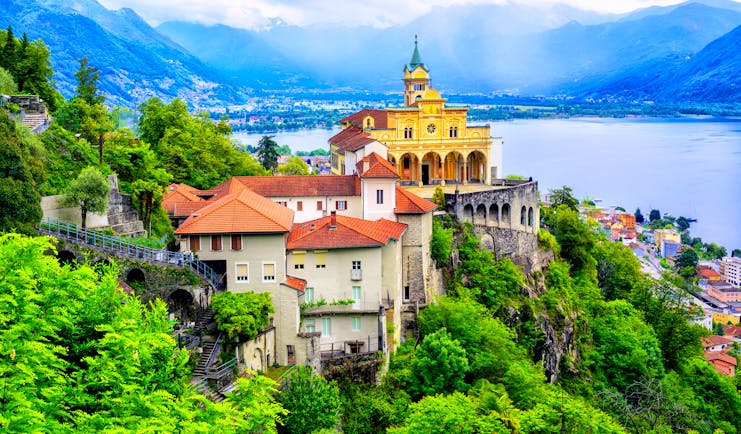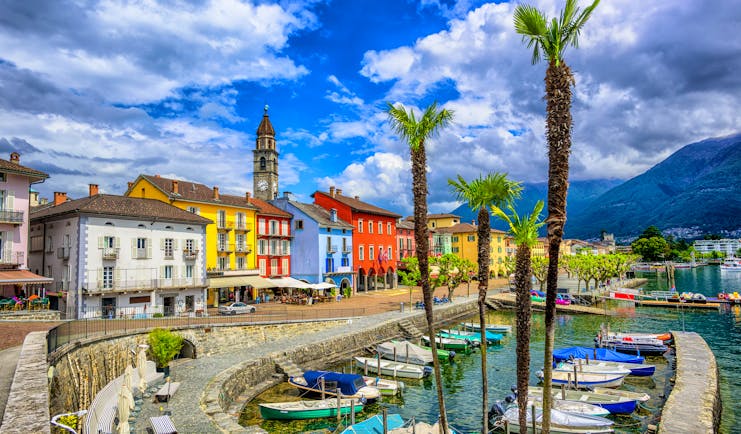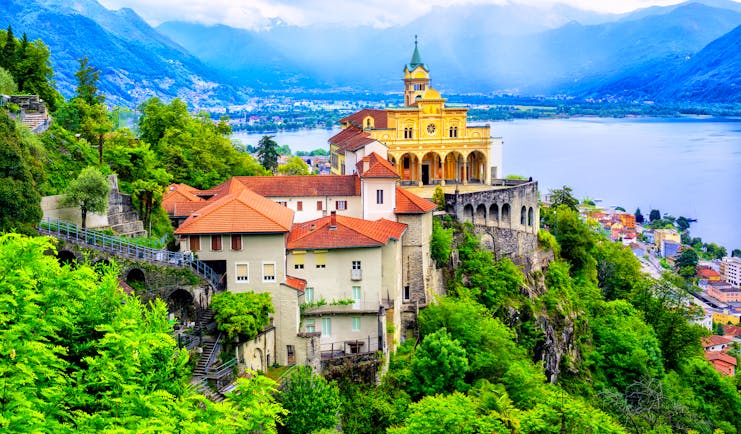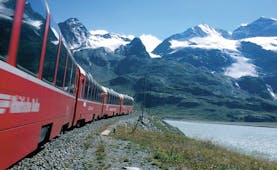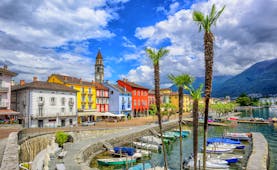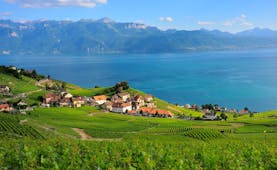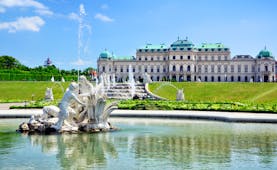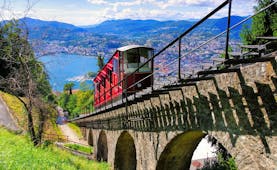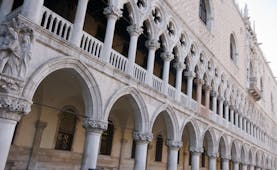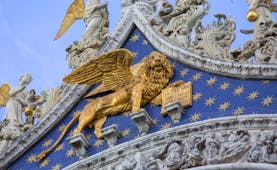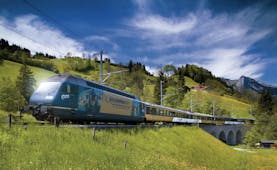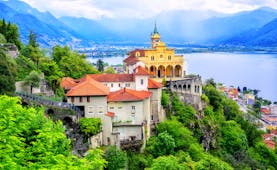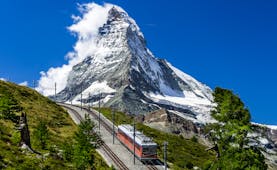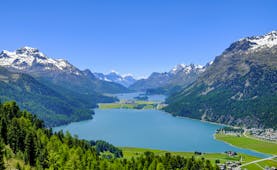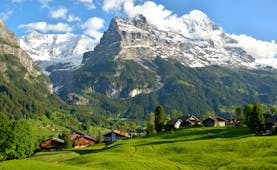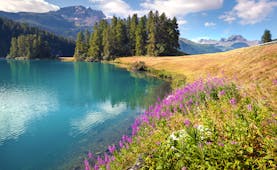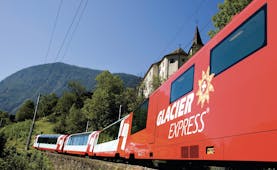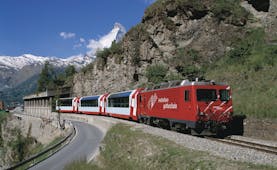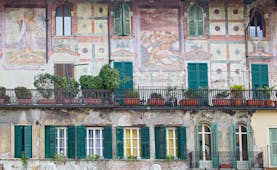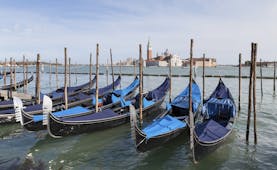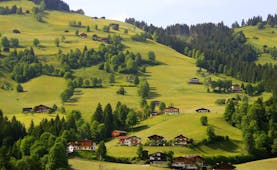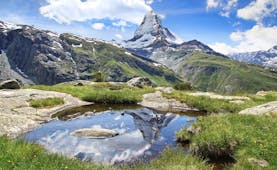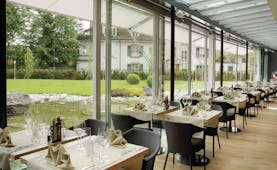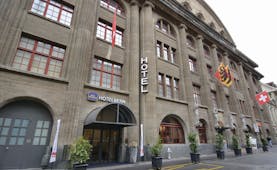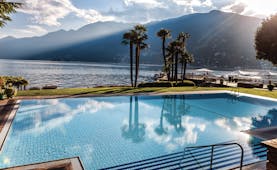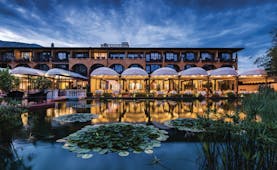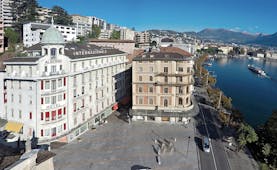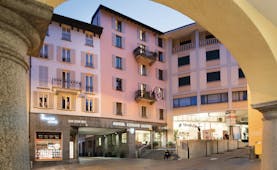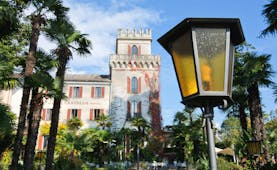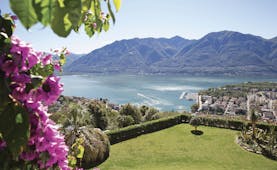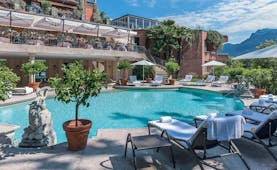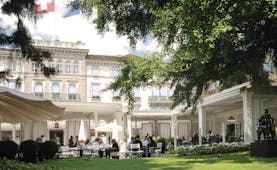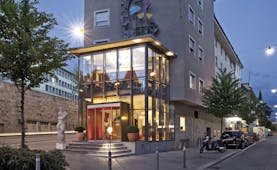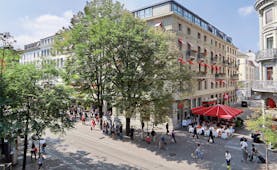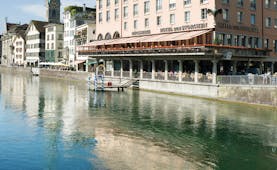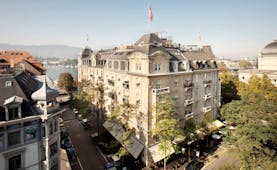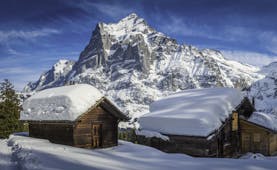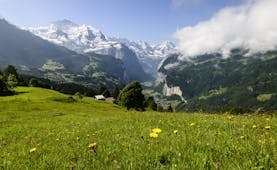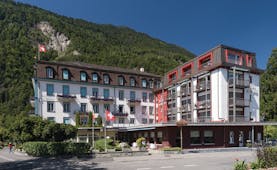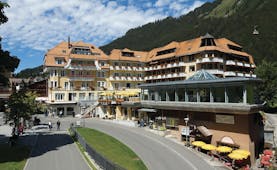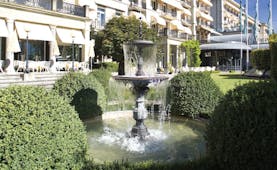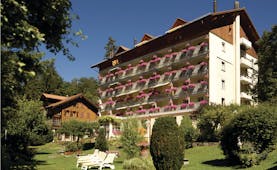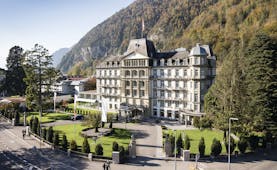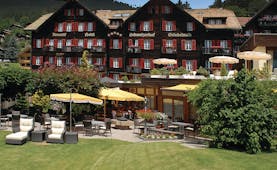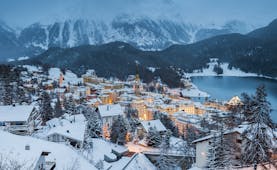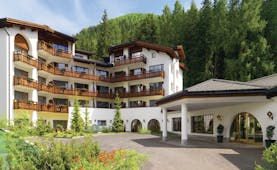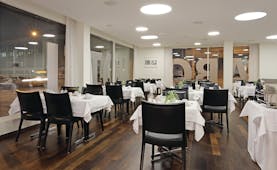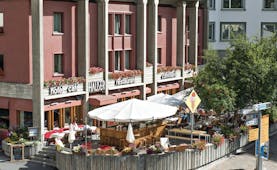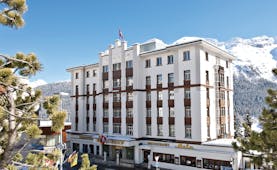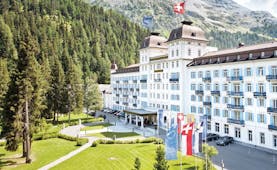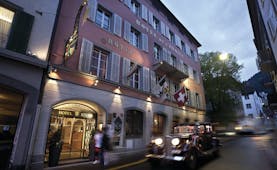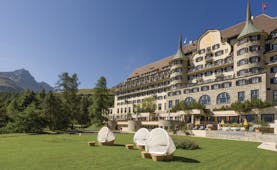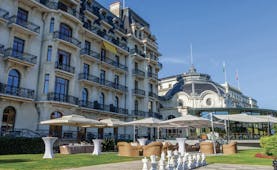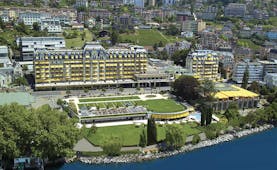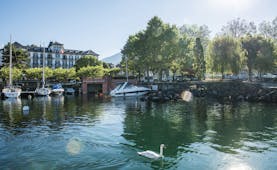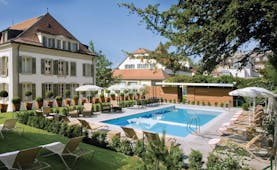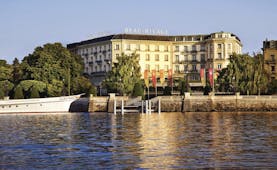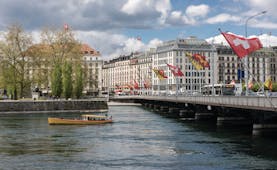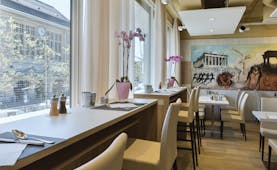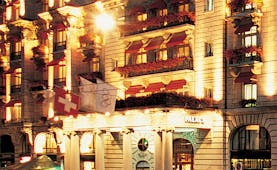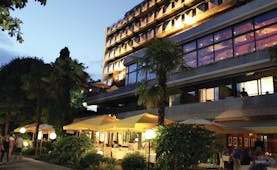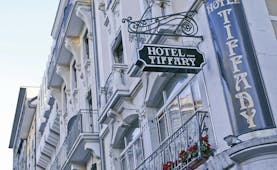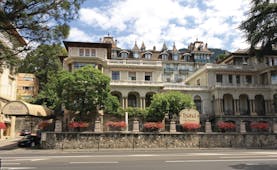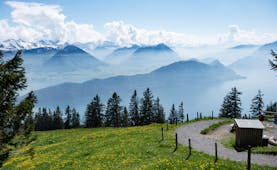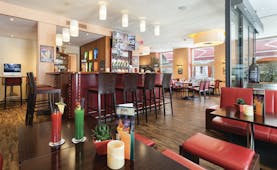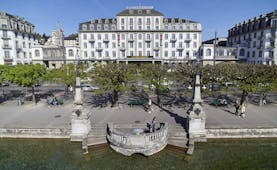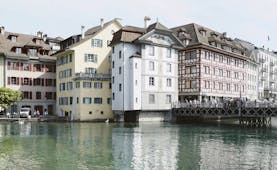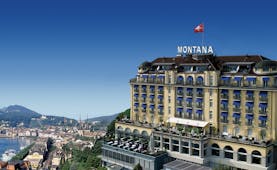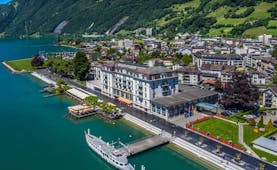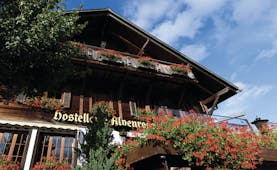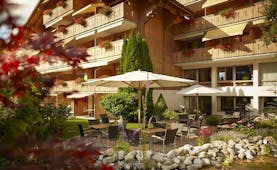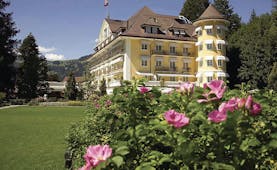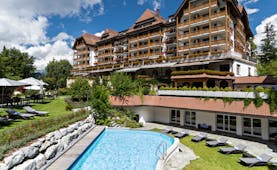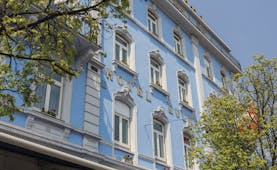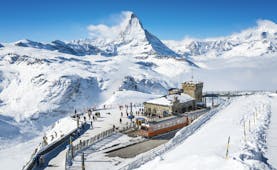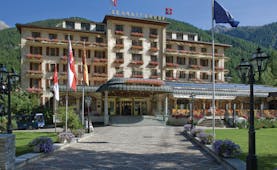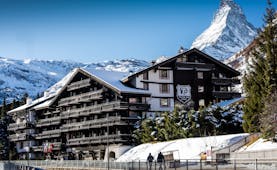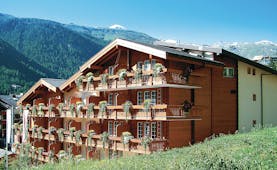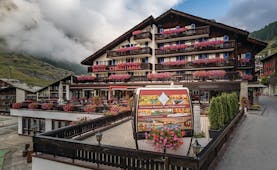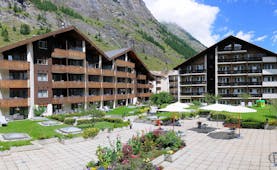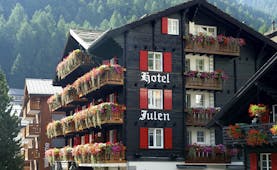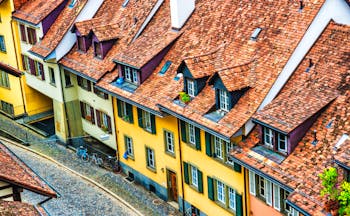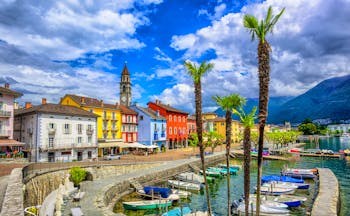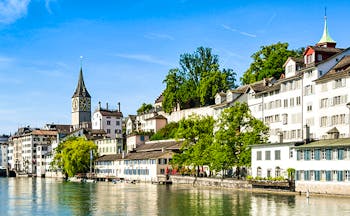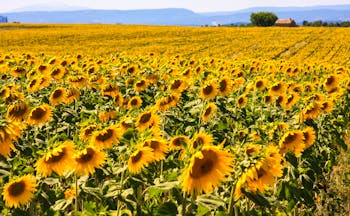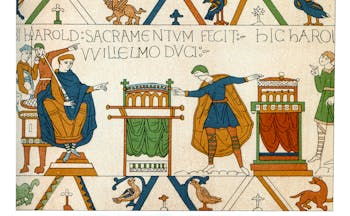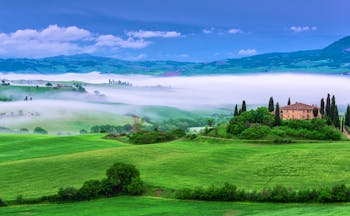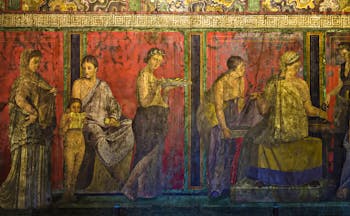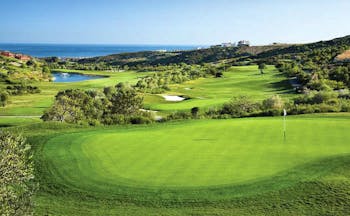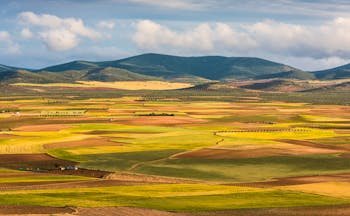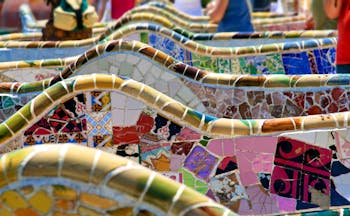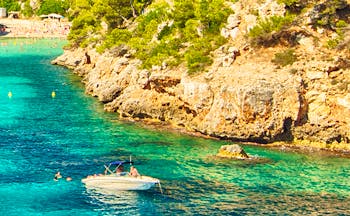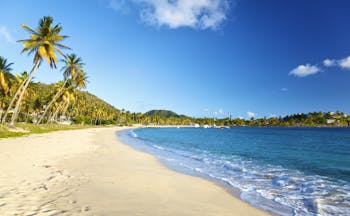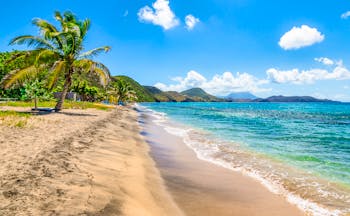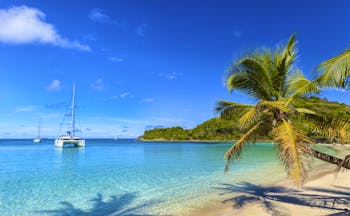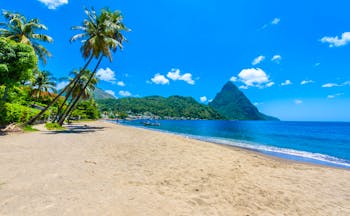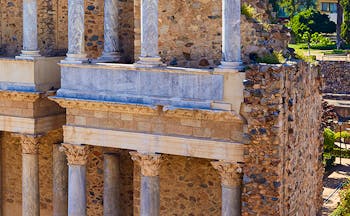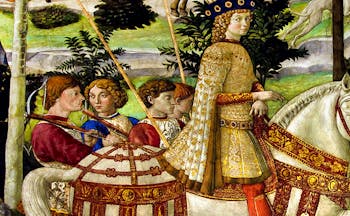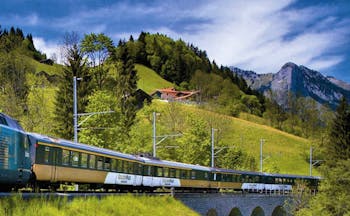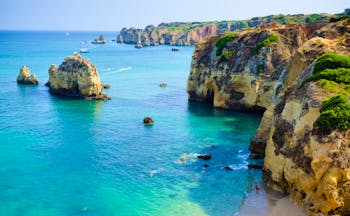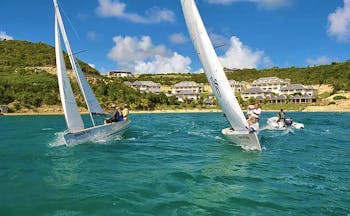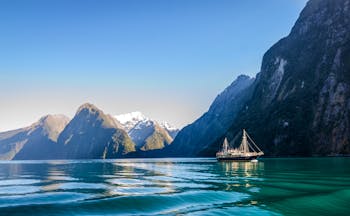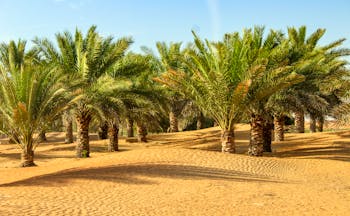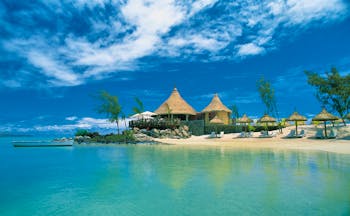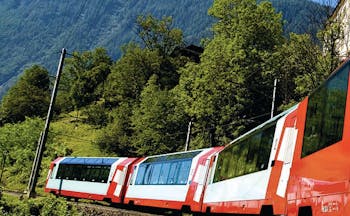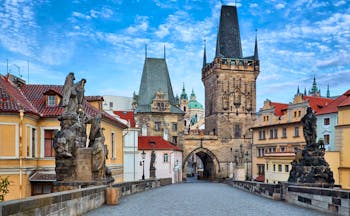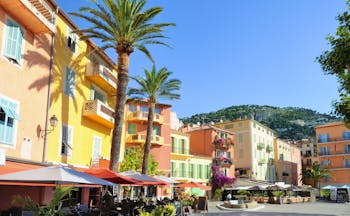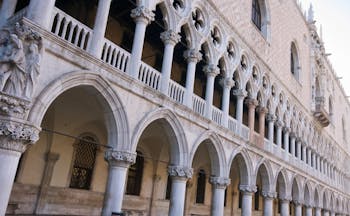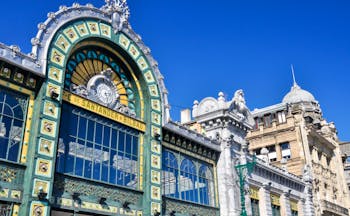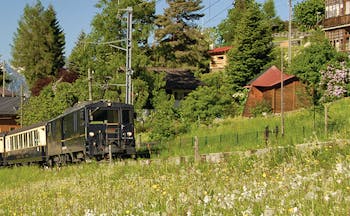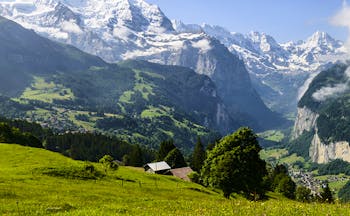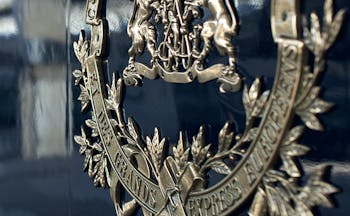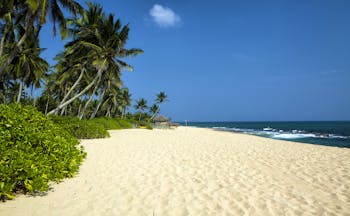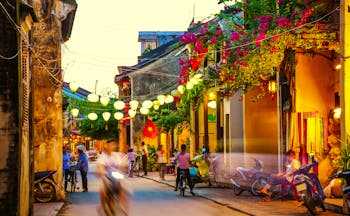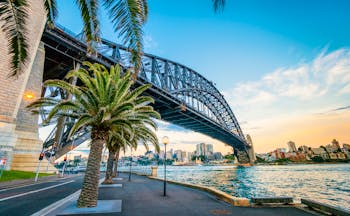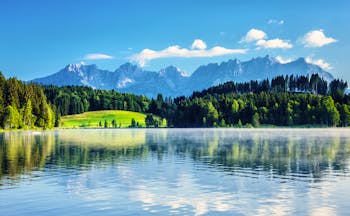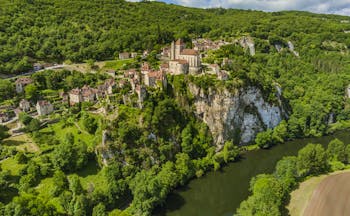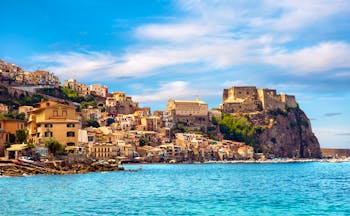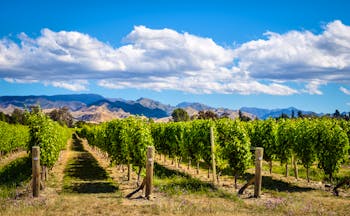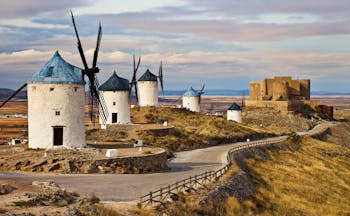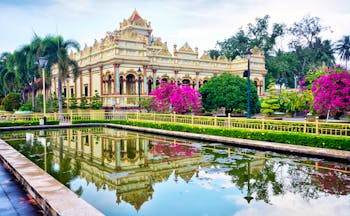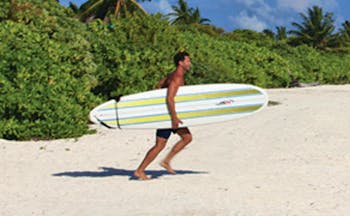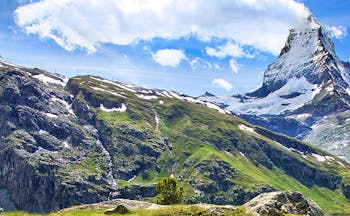Luxury Swiss iconic rail holiday on the Centovalli Express
This 5-night Centovalli Express rail touring holiday begins with your arrival into Zurich, either by plane or by rail via France. Spend one night at your choice of Zurich hotel, taking time to explore this famous city and enjoy Lake Zurich. On your second day, catch a train from Zurich to Locarno, taking approximately three hours, where you will spend three nights. On your fifth day, you board the Centovalli Express from Locarno, through Domodossola, to Brig, arriving three hours later if you do not choose to stop. Perhaps spend a few hours in this historic town before catching another train to Bern, where you will stay for your final night. From Bern, return to Zurich for your flight back to the UK or take the train back to London via Paris.
Highlights
Locarno • Ponte Brolla • Tegna • Verscio • Cavigliano • Intragna • Corcapolo • Verdasio • Palagnedra • Camedo • Ribellasca • Re • Malesco • Santa Maria Maggiore • Druogno • Coimo • Marone • Verigo • Trontano • Creggio • Masera • Domodossola
Day by day
Fly into Zurich on your first day, arriving early afternoon, or journey from London by train, arriving in the late afternoon. If time permits, spend a few hours exploring the city. Make sure you have time to visit the Grossmunster Church, perhaps climbing the Karlsturm, one of the church’s two iconic towers. Enjoy the pretty streets, cafes, and boutiques of Zurich’s old town, and have dinner either at your luxury hotel or in one of the many high-class gourmet restaurants in this area.
Say goodbye to Zurich and board a train south to Locarno in the province of Ticino. This journey will take approximately three hours, ideally arriving mid-afternoon. Once in Locarno, transfer to your hotel for 2 nights, using the time to explore the Swiss side of Lake Maggiore and the romantic rolling plains of Ticino.
On one of your second days in Locarno, perhaps venture outside Locarno to see the turquoise, clear waters of the rivers and streams around the lake, to relax on a lake cruise, or to climb up to the Cadada Cimetta, from where you can see both the highest and lowest parts of Switzerland in one glance: the Valais High Alps and Lake Maggiore. Return to your hotel for dinner and a restful evening.
In the late morning of your last day in Locarno, board the Centovalli Express to Domodossola; a journey that takes around two hours. Getting its name from the Hundred Valleys region through which it passes, the Centovalli Express offers the most direct connection between the Gotthard and Simplon Railways. Besides this, its combination of tunnels, turns, bridges, and panoramic views make it an interesting, scenic route, passing Lake Maggiore and the northern Italian valleys. Take in views of rocky mountains, gushing waterfalls, rich vegetation, vineyards, clusters of chestnut trees, colourful glades, and small historic villages as you pass, travelling over 47 bridges while in Switzerland, and 36 in Italy. This popular route, voted one of the most romantic in Europe, begins in Locarno, on the banks of Lake Maggoire. Locarno has the warmest climate in Switzerland, giving it a decidedly Mediterranean feel and encouraging the cultivation of a diverse range of natural flora and fauna. Before boarding the train, take the time to enjoy the many sites of natural beauty that surround the city, from the Cardada Cimetta, which allows you to witness the highest and lowest parts of Switzerland, the Valais High Alps and Lake Maggiore, simultaneously. Water sports and lake cruises are available at the lake, or stay further inland to weave your way through the Magic Valley or the Verzasca Valley, notable for its rich green-turquoise waters. For a taste of the religious heritage within the city, visit the late 17th century Church of St Anthony, the 16th century Church of San Francesco, the mid-17th century New Church, or the late 15th century Sanctuary of the Madonna del Sasso. The most intriguing monument in the city, however, is recognised to be the Visconti Castle, in which there is a permanent exhibition of Roman glass. Time your stay here for mid-week to enjoy the sights, sounds, and fragrances of the Thursday town market. Depending on the service and time of day, the number of stops on the Centovalli route change. For your convenience, we have selected the most prominent and the most frequent in our description of the journey. Once acquainted with the regularity of the trains, it is possible to stop for an hour in any of the locations mentioned here to explore the Hundred Valleys in more depth. One of the first stops once the train is outside Locarno is Ponte Brolla, named after the iron bridge crossing the turbulent Maggia River. Rocky gorges, popular with daring cliff divers, eerie tunnels, and ethereal caverns have been shaped by the powerful flow of the vibrant turquoise water. 40 ancient grottos sit beneath the rock surface, which were once used to store agricultural produce. The Centovalli Express then continues to its most northern point in Tegna. Here, the ruins of a prehistoric settlement sit an hour’s walk above the village. Shallow river beaches and smooth shelves of rock line the banks of the Maggia River, which are popular with swimmers in the summer months, but picturesque all year round. From Tegna, the train begins to travel southeast, first stopping in Verscio. Following the slopes of Pedemonte, Verscio is a traditional Ticino village. Grey stone houses topped with ramshackle tiled roofs sit beside houses coated in bright plaster. Narrow cobbled streets guide visitors, sheltered by the tall townhouses on either side. On higher ground, the unique, quirky 13th century San Fedele Church gazes over the village, next to the red crown of the bell and clock tower. Inside, it contains frescoes by Antonio da Tradate. Only a few minutes away is the next stop, Cavigliano. Here, the flat land opens out further between the mountains, with neatly organised agricultural fields and plumes of evergreen trees. At the centre stands the Church of San Michele, built in the late 16th century, but Cavigliano’s biggest treasure is probably the old wine press, the keys for which can only be obtained from the Town Hall. The Roman-style Cratolo Bridge marks the beginning of the Onsernone Valley. Next, you will find yourself in Intragna, home to a series of iron bridges that cross the Isorno torrent. A Roman bridge also arches over the white rock and jade waters. We would recommend alighting here to visit the many cultural and natural attractions. Within the town, visit the Church of San Gottardo, built in the early 18th century, though the oratory dates back to the 15th. The bell tower, built in the late 18th century is the tallest in Ticino, reaching 65m and with 166 steps from bottom to top. The Intragna-Pila-Costa Cableway will take you high up onto the mountainside, or, stay closer to sea level to visit the Regional Museum of Centovalli and Pedemonte. Many hiking paths, reached through a curved tunnel, originate at the next stop: Corcapolo. The houses here are few and far between, clinging to the steeply sloped mountainside. Pass through Corcapolo to Verdasio, another quiet stop that sees the train zigzag in and out of tunnels. Those seeking even more stunning panoramas than the ones the Centovalli rail line has to offer, may alight here to take the Monte Camino cable car up to Rasa, at 900m above sea level. The traffic free village of Rasa can only be accessed on foot or by cable car, so retains much of its idyllic charm, surrounded by fields of flowers, dense forests, and rural walkways lined with dry stone walls. At the village centre stands the 18th century Church of St Anne. Return to the train to continue on to Palagnedra. The train station is situated on the edge of the artificial Palagnedra Lake, at the foot of the winding road that takes you up on to the flat clearing in which the town itself sits. As you reach the top, the San Michele Church is directly on your right, adorned with more frescoes by Antonio da Tradate, dating from the 15th century. The houses are simply built out of stone and plaster, with a rural-Italian feel. Below the village is the Fenacci Mill, the only mill in the region that still has its original interior milling parts. After exploring Palagnedra, re-board the train as it follows the shore of the lake and heads on towards Camedo, the next stop on this journey. Camedo is home to more iron bridges, which overlook one another. The railway bridge, high on the mountainside above the Melezza River, has become an iconic image for the Centovalli Express. Camedo has a very isolated feel, due to the imposing mountains that seem to curve around the town and the meandering course of the river, and is populated by colourfully decorated houses. Before reaching its next stop, the Centovalli Express crosses the border into Italy. Within a minute of touching Italian soil, the train stops in Ribellasca. From here, the Centovalli moves on to Re, home to the Sanctuary of the Madonna of the Blood; a stunning pale stone building built on an arcaded stone platform on the edge of the mountain slope. Silver domes and peaks tops its many cylindrical towers, and tall, thin windows add a Medieval feel. Behind it, the white-washed, brown-roofed houses cluster. The grandeur of this central building is reflected in the translation of the town’s name: king. On a stretch of flat land further east is Malesco, the Centovalli’s next stop. Here you will find the Church of St Peter and Paul, though the scenery around Malesco can be easily enjoyed from your train carriage. Drawing to the end of the long valley, your next stop is in Santa Maria Maggiore. The unique cultural attractions here include the Museum of Chimney Sweeps and the Delle Arti School Rossetti Valentini. Peaceful streets are lined with detached chalet-esque houses with wooden balconies and shutters. As the valley becomes narrower and the forest becomes denser, the towns and villages become smaller. Druogno is a small town that epitomises quaint rural life; each house is unique, with coloured walls, fenced gardens, and breath-taking views. Beyond Druogno, however, the train stations are situated outside their corresponding villages, in the heart of the forest. Through Coimo, Marone, and Verigo, we would recommend remaining on the train to enjoy the wooded scenery. Trontano marks the widening of the valley and the beginning of your entry into Domodossola. Modern meets traditional in the style of the architecture, with heavy influences from traditional Swiss chalets, but white-washed walls and sleek slatework. Heading down the hillside, the Centovalli stops off in rural Creggio, from where you can look out towards Domodossola nestled between the three mountains in the distance. Cross over the River Melezzo once more to reach Masera, before heading into your final stop: Domodossola. The tall townhouses of Domodossola crowd around vast squares, each with individually arcaded ground floors with shops and pavement cafes. On the central square, Piazza Mercato, the bourgeois buildings have unique balconies and loggias. Each building seems to lean onto its neighbours, with a unique roof, wall colour, and window style, giving this city an infectious charm. While in Domodossola, visit the 14th century Briona Tower, the Teatro Galletti, one of the most active theatres in the province, the 14th century Palazzo Silva, now an Etruscan, Roman, and Egyptian museum, the Collegiate Church, and the Sacro Monte del Calvario, a UNESCO World Heritage Site built by Capuchin Monks. In the Motta District, some houses still have their Medieval wooden balconies. Then, when your exploration is complete, board another train to Brig. This fairly direct route takes less than half an hour and makes very few stops, giving you time to sit back and fully enjoy the views across the mountains and valleys without interruption. Once in Brig, you have the option to take a self-guided tour around the cobbled streets, stopping at the Stockalper Castle, which is undoubtedly the town’s most impressive monument. Your train will then take you north to Bern, the Swiss capital, where you will be staying.
Bern is tucked away on a meander of the Aare River and home to a beautiful Old Town that is continually popular with artists and writers. Over 100 fountains are dotted around the city, some dating back to the Middle Ages, and some topped with folkloric figures. Key cultural sites in Bern include the House of Parliament, topped by an iconic copper-clad dome, Bern Cathedral, the largest ecclesiastical building in Switzerland, the Bernisches Historisches Museum, housing an Einstein exhibit and several Burgundy tapestries, and the astronomical Zytglogge Clock Tower, with its revolving faces and unique hands. Perhaps extend your stay here to ensure you have time to explore the whole city; otherwise, continue on to Zurich for your return flight to the UK. You may choose to travel home by train, in which case we would recommend spending an extra night in Zurich.
Thank you. We had an amazing holiday. Really appreciate the work put in to give us the trip of a lifetime!Mrs H, Jan 2023
Holiday price guide From about £1,895 per person based on two people sharing a double room and including for second class rail travel. First class supplement from £595 per person.
Holiday Code CHBR02
Call us on 01392 441245
Luxury Swiss iconic rail holiday on the Centovalli Express
Fly into Zurich on your first day, arriving early afternoon, or journey from London by train, arriving in the late afternoon. If time permits, spend a few hours exploring the city. Make sure you have time to visit the Grossmunster Church, perhaps climbing the Karlsturm, one of the church’s two iconic towers. Enjoy the pretty streets, cafes, and boutiques of Zurich’s old town, and have dinner either at your luxury hotel or in one of the many high-class gourmet restaurants in this area.
Say goodbye to Zurich and board a train south to Locarno in the province of Ticino. This journey will take approximately three hours, ideally arriving mid-afternoon. Once in Locarno, transfer to your hotel for 2 nights, using the time to explore the Swiss side of Lake Maggiore and the romantic rolling plains of Ticino.
On one of your second days in Locarno, perhaps venture outside Locarno to see the turquoise, clear waters of the rivers and streams around the lake, to relax on a lake cruise, or to climb up to the Cadada Cimetta, from where you can see both the highest and lowest parts of Switzerland in one glance: the Valais High Alps and Lake Maggiore. Return to your hotel for dinner and a restful evening.
In the late morning of your last day in Locarno, board the Centovalli Express to Domodossola; a journey that takes around two hours. Getting its name from the Hundred Valleys region through which it passes, the Centovalli Express offers the most direct connection between the Gotthard and Simplon Railways. Besides this, its combination of tunnels, turns, bridges, and panoramic views make it an interesting, scenic route, passing Lake Maggiore and the northern Italian valleys. Take in views of rocky mountains, gushing waterfalls, rich vegetation, vineyards, clusters of chestnut trees, colourful glades, and small historic villages as you pass, travelling over 47 bridges while in Switzerland, and 36 in Italy. This popular route, voted one of the most romantic in Europe, begins in Locarno, on the banks of Lake Maggoire. Locarno has the warmest climate in Switzerland, giving it a decidedly Mediterranean feel and encouraging the cultivation of a diverse range of natural flora and fauna. Before boarding the train, take the time to enjoy the many sites of natural beauty that surround the city, from the Cardada Cimetta, which allows you to witness the highest and lowest parts of Switzerland, the Valais High Alps and Lake Maggiore, simultaneously. Water sports and lake cruises are available at the lake, or stay further inland to weave your way through the Magic Valley or the Verzasca Valley, notable for its rich green-turquoise waters. For a taste of the religious heritage within the city, visit the late 17th century Church of St Anthony, the 16th century Church of San Francesco, the mid-17th century New Church, or the late 15th century Sanctuary of the Madonna del Sasso. The most intriguing monument in the city, however, is recognised to be the Visconti Castle, in which there is a permanent exhibition of Roman glass. Time your stay here for mid-week to enjoy the sights, sounds, and fragrances of the Thursday town market. Depending on the service and time of day, the number of stops on the Centovalli route change. For your convenience, we have selected the most prominent and the most frequent in our description of the journey. Once acquainted with the regularity of the trains, it is possible to stop for an hour in any of the locations mentioned here to explore the Hundred Valleys in more depth. One of the first stops once the train is outside Locarno is Ponte Brolla, named after the iron bridge crossing the turbulent Maggia River. Rocky gorges, popular with daring cliff divers, eerie tunnels, and ethereal caverns have been shaped by the powerful flow of the vibrant turquoise water. 40 ancient grottos sit beneath the rock surface, which were once used to store agricultural produce. The Centovalli Express then continues to its most northern point in Tegna. Here, the ruins of a prehistoric settlement sit an hour’s walk above the village. Shallow river beaches and smooth shelves of rock line the banks of the Maggia River, which are popular with swimmers in the summer months, but picturesque all year round. From Tegna, the train begins to travel southeast, first stopping in Verscio. Following the slopes of Pedemonte, Verscio is a traditional Ticino village. Grey stone houses topped with ramshackle tiled roofs sit beside houses coated in bright plaster. Narrow cobbled streets guide visitors, sheltered by the tall townhouses on either side. On higher ground, the unique, quirky 13th century San Fedele Church gazes over the village, next to the red crown of the bell and clock tower. Inside, it contains frescoes by Antonio da Tradate. Only a few minutes away is the next stop, Cavigliano. Here, the flat land opens out further between the mountains, with neatly organised agricultural fields and plumes of evergreen trees. At the centre stands the Church of San Michele, built in the late 16th century, but Cavigliano’s biggest treasure is probably the old wine press, the keys for which can only be obtained from the Town Hall. The Roman-style Cratolo Bridge marks the beginning of the Onsernone Valley. Next, you will find yourself in Intragna, home to a series of iron bridges that cross the Isorno torrent. A Roman bridge also arches over the white rock and jade waters. We would recommend alighting here to visit the many cultural and natural attractions. Within the town, visit the Church of San Gottardo, built in the early 18th century, though the oratory dates back to the 15th. The bell tower, built in the late 18th century is the tallest in Ticino, reaching 65m and with 166 steps from bottom to top. The Intragna-Pila-Costa Cableway will take you high up onto the mountainside, or, stay closer to sea level to visit the Regional Museum of Centovalli and Pedemonte. Many hiking paths, reached through a curved tunnel, originate at the next stop: Corcapolo. The houses here are few and far between, clinging to the steeply sloped mountainside. Pass through Corcapolo to Verdasio, another quiet stop that sees the train zigzag in and out of tunnels. Those seeking even more stunning panoramas than the ones the Centovalli rail line has to offer, may alight here to take the Monte Camino cable car up to Rasa, at 900m above sea level. The traffic free village of Rasa can only be accessed on foot or by cable car, so retains much of its idyllic charm, surrounded by fields of flowers, dense forests, and rural walkways lined with dry stone walls. At the village centre stands the 18th century Church of St Anne. Return to the train to continue on to Palagnedra. The train station is situated on the edge of the artificial Palagnedra Lake, at the foot of the winding road that takes you up on to the flat clearing in which the town itself sits. As you reach the top, the San Michele Church is directly on your right, adorned with more frescoes by Antonio da Tradate, dating from the 15th century. The houses are simply built out of stone and plaster, with a rural-Italian feel. Below the village is the Fenacci Mill, the only mill in the region that still has its original interior milling parts. After exploring Palagnedra, re-board the train as it follows the shore of the lake and heads on towards Camedo, the next stop on this journey. Camedo is home to more iron bridges, which overlook one another. The railway bridge, high on the mountainside above the Melezza River, has become an iconic image for the Centovalli Express. Camedo has a very isolated feel, due to the imposing mountains that seem to curve around the town and the meandering course of the river, and is populated by colourfully decorated houses. Before reaching its next stop, the Centovalli Express crosses the border into Italy. Within a minute of touching Italian soil, the train stops in Ribellasca. From here, the Centovalli moves on to Re, home to the Sanctuary of the Madonna of the Blood; a stunning pale stone building built on an arcaded stone platform on the edge of the mountain slope. Silver domes and peaks tops its many cylindrical towers, and tall, thin windows add a Medieval feel. Behind it, the white-washed, brown-roofed houses cluster. The grandeur of this central building is reflected in the translation of the town’s name: king. On a stretch of flat land further east is Malesco, the Centovalli’s next stop. Here you will find the Church of St Peter and Paul, though the scenery around Malesco can be easily enjoyed from your train carriage. Drawing to the end of the long valley, your next stop is in Santa Maria Maggiore. The unique cultural attractions here include the Museum of Chimney Sweeps and the Delle Arti School Rossetti Valentini. Peaceful streets are lined with detached chalet-esque houses with wooden balconies and shutters. As the valley becomes narrower and the forest becomes denser, the towns and villages become smaller. Druogno is a small town that epitomises quaint rural life; each house is unique, with coloured walls, fenced gardens, and breath-taking views. Beyond Druogno, however, the train stations are situated outside their corresponding villages, in the heart of the forest. Through Coimo, Marone, and Verigo, we would recommend remaining on the train to enjoy the wooded scenery. Trontano marks the widening of the valley and the beginning of your entry into Domodossola. Modern meets traditional in the style of the architecture, with heavy influences from traditional Swiss chalets, but white-washed walls and sleek slatework. Heading down the hillside, the Centovalli stops off in rural Creggio, from where you can look out towards Domodossola nestled between the three mountains in the distance. Cross over the River Melezzo once more to reach Masera, before heading into your final stop: Domodossola. The tall townhouses of Domodossola crowd around vast squares, each with individually arcaded ground floors with shops and pavement cafes. On the central square, Piazza Mercato, the bourgeois buildings have unique balconies and loggias. Each building seems to lean onto its neighbours, with a unique roof, wall colour, and window style, giving this city an infectious charm. While in Domodossola, visit the 14th century Briona Tower, the Teatro Galletti, one of the most active theatres in the province, the 14th century Palazzo Silva, now an Etruscan, Roman, and Egyptian museum, the Collegiate Church, and the Sacro Monte del Calvario, a UNESCO World Heritage Site built by Capuchin Monks. In the Motta District, some houses still have their Medieval wooden balconies. Then, when your exploration is complete, board another train to Brig. This fairly direct route takes less than half an hour and makes very few stops, giving you time to sit back and fully enjoy the views across the mountains and valleys without interruption. Once in Brig, you have the option to take a self-guided tour around the cobbled streets, stopping at the Stockalper Castle, which is undoubtedly the town’s most impressive monument. Your train will then take you north to Bern, the Swiss capital, where you will be staying.
Bern is tucked away on a meander of the Aare River and home to a beautiful Old Town that is continually popular with artists and writers. Over 100 fountains are dotted around the city, some dating back to the Middle Ages, and some topped with folkloric figures. Key cultural sites in Bern include the House of Parliament, topped by an iconic copper-clad dome, Bern Cathedral, the largest ecclesiastical building in Switzerland, the Bernisches Historisches Museum, housing an Einstein exhibit and several Burgundy tapestries, and the astronomical Zytglogge Clock Tower, with its revolving faces and unique hands. Perhaps extend your stay here to ensure you have time to explore the whole city; otherwise, continue on to Zurich for your return flight to the UK. You may choose to travel home by train, in which case we would recommend spending an extra night in Zurich.
Thank you. We had an amazing holiday. Really appreciate the work put in to give us the trip of a lifetime!Mrs H, Jan 2023
Holiday price guide From about £1,895 per person based on two people sharing a double room and including for second class rail travel. First class supplement from £595 per person.
Holiday Code CHBR02
Our prices include
● Flights from UK to Zurich and back from Zurich OR rail travel London to Switzerland and back via Paris (first class can be booked at a supplement)
● 4-day Swiss rail flex pass (first class can be booked at a supplement)
● Centovalli Express journey
● 1 night’s bed and breakfast in a Classic double room at the Hotel St Gotthard, Zurich
● 3 nights’ bed and breakfast in a Standard double room at the Romantik Hotel Castello Seeschloss, Ascona
● 1 night’s bed and breakfast in a Standard double room at the Hotel Bern, Bern
● Concierge service and Expressions Holidays regional helpful hints
Our prices do not include
● Early check-in or late check-out at any hotels (although we can arrange this on request at additional cost)
● Any other services not mentioned above, such as transfers and meals except breakfast at hotels
● Personal holiday insurance. This is essential and cover should be in place from when you book the holiday.
● Local tourist tax, usually between Swiss Francs 1 and 3 per person per night, and payable locally to the hotel
● Optional extra nights in Zurich, Ascona, Bern, Zermatt, or Geneva
● Transfers in Switzerland station to hotel unless offered by your hotel
● Transfers in Paris if travelling by train from London to Switzerland
● A luggage transfer service is available within Switzerland – please contact us for further details
Call us on 01392 441245
Luxury Swiss iconic rail holiday on the Centovalli Express
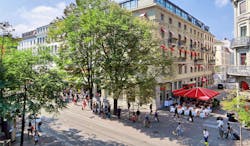
Hotel St Gotthard is a sophisticated 4-star hotel in an excellent central location. Haute cuisine and stylish, comfortable accommodation make this an excellent spot to recuperate after enjoying the cultural delights of Zurich.
Classic double room
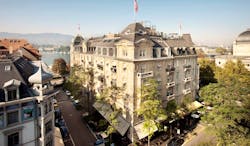
The Romantik Hotel Europe in Zurich is a charming, boutique, family-run hotel with 39 rooms just two minutes’ walk from the shores of Lake Zurich and by the Opera House.
Classic double room
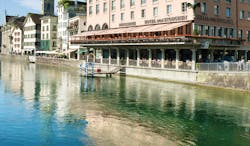
Hotel Storchen is an elegant and refined 5-star boutique hotel in a beautiful waterfront location. Delicious cuisine and luxurious accommodation make this an excellent spot to recuperate after enjoying the cultural and historical delights of Zurich.
Classic double room
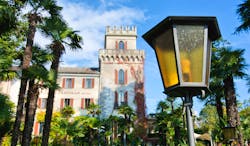
Romantik Hotel Castello Seeschloss is a charming 4-star boutique hotel in a beautiful waterfront location. With comfortable accommodation and delicious cuisine, as well as idyllic, serene views afford guests a luxurious, relaxing retreat.
Standard double room
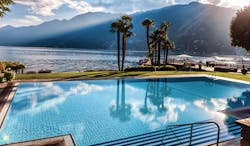
Hotel Eden Roc is a 5-star deluxe hotel in a stunning lakefront location. A variety of delicious cuisine, superb, extensive spa facilities and stunning luxury amenities afford guests a truly relaxing and indulgent experience.
Standard double room
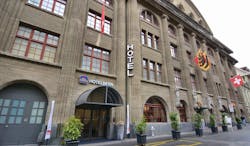
Hotel Bern is a 4-star hotel offering excellent value for money in an excellent central location. Modern accommodation and delicious cuisine make this an ideal spot to recuperate after enjoying the delights of Bern.
Standard double room
Thank you. We had an amazing holiday. Really appreciate the work put in to give us the trip of a lifetime!Mrs H, Jan 2023
Holiday price guide From about £1,895 per person based on two people sharing a double room and including for second class rail travel. First class supplement from £595 per person.
Holiday Code CHBR02
Call us on 01392 441245
Luxury Swiss iconic rail holiday on the Centovalli Express
About Bern
An Expressions tailor-made holiday to Bern takes travellers on an unusual meander of the Aare River to Switzerland's capital city, Bern. Just outside Bern is the Wohlensee, a long and winding lake with verdant islands and numerous small rocky beaches with jetties for kayaks and rowing boats. This small lake sets the scene for the rest of the canton, dotted with medieval towns and villages, and swept by undulating agricultural fields, small forests, and abrupt rocky bluffs. In the distance, away from the city, the flat land gently slopes up to the low peaks of hills quilted in trees, with the snowy Alps behind them. This German-speaking region is separated from France only by a small stretch of the Parc Naturel Regional des Doubs but has a very strong individual identity. The towns around the city of Bern are wholly unique in their character, with a blend of styles and influences that holds its own. Festivals and celebrations at castles and on medieval streets take visitors and residents back to the region's origins, and sweet and savoury delicacies add to the overall flavour of the communities. Rivers wind around perfectly round hills, roads meander their ways through valleys and between lakes, and the quaint towns and immeasurably grand and cultural cities are full of luxury hotels with plenty to offer their guests.
Highlights of Bern
The city of Bern itself is undoubtedly the main attraction of this region. The beautifully preserved Old Town has remained popular with artists and writers throughout history, with an infectious, laid-back atmosphere. Fountains, enumerating more than 100 and dating from the Middle Ages, dot the streets, topped with colourful statues of folkloric and historic figures. A late Gothic town hall is the seat of the local political decisions in Bern, though the sensational House of Parliament provides a much grander, more ornate face for Swiss diplomacy. The main copper-clad dome has become a well-known image associated with the city. Parliament Square is possibly the best place to enjoy the majesty and grandeur of Bern, with jets of water, which represent the 26 cantons, that are illuminated in the evening, and an ice rink in the winter. Bern Cathedral is the largest ecclesiastical building in Switzerland and its construction originally begun in the early 15th century; the spire was not completed until the late 19th century. From the top of the spire, visitors can enjoy views all the way into the Bernese-Mittelland, with the grand silhouettes of the Alps rising in the distance. For a further taste of Bern's history, spend an hour or two at the Bernisches Historisches Museum, which also has an inbuilt Einstein Museum. The artefacts and exhibits here are recognised to be world-class, with Burgundy tapestries, ethnographic objects, and prehistoric remains. However, what may be the most iconic symbol for Bern, is the astronomical Zytglogge Clock Tower, with its several revolving faces and unique hands. To the east of the city of Bern is the region of Emmental, where dairy farming comprises the main economy and two river basins make the land remarkably flat in comparison to the snow-capped Alps on the horizon. Irregularly-shaped fields are lush shades of green and grazed on by cattle. Should you head out this way while staying in Bern, ensure you pick up some Emmental cheese from its place of origin. For an insight into this picturesque agricultural region, drive or catch a train to Burgdorf to visit the Castle Museum Burgdorf, the former home of the Dukes of Zahringen. Alternatively, visit the Regional Museum Chuechlichus Langnau, which is housed in one of the region's oldest buildings. In Affoltern im Emmental, be sure to visit the Emmental Show Dairy, with its cheese factory, two restaurants, and small village atmosphere. To the west of Bern is the Gantrisch Nature Park, a rightly-preserved expanse of green plains interspersed with canyons, quaint villages, unusually-shaped jagged mountain bluffs, and rare wild- and plant-life. Some highlights of the Park, aside from the numerous hiking and walking paths, include the atmospheric ruins of the 11th century Rueggisberg Priory and the Uecht Observatory, which affords visitors stunning views across the miles-upon-miles of surrounding countryside.
Cultural highlights of Bern
On the border between the cantons of Bern and Fribourg is the small region of Laupen. The little town of the same name has a beautiful medieval centre with original 11th century houses. Laupen is the perfect place to soak up a sense of culture outside of Bern, with examples of traditional craftsmanship, ancient monuments, and the agricultural way of life. Laupen Castle sits on the confluence of the Sense and Saane Rivers, a position that gave it a significant advantage in the 14th century against the Habsburgs. Today, its tall stone walls are topped with towers and houses that have dark wooden beams and peaked terracotta-tile roofs. At the entrance, a pretty chalet-esque house with pink flower window-boxes supports part of the archway. The views from the top transport you back in time with views over more terracotta roofs, this time on the white-washed houses of the town. In the far east of the Canton of Bern is the Oberaargau Region, which is a natural haven for outdoorsy visitors, and therefore the perfect place to enjoy long scenic bike rides, gentle strolls, and slow boat trips past meadows. We would highly recommend paying a visit to the Burgaschsee, believed to be a remnant of the Rhone Glacier, as well as the water meadows that are the last preserved in the country, the ethereal 14m high Mutzbackfall, and the St. Urban former monastery. Whichever part of the canton your exploration is focused on, Bern has an abundance of natural, cultural, and historic attractions that will surely keep you entertained for days.
Festivals in Bern
Due to the history of the Bern area, throughout the year there are a vast number of festivals which celebrate traditional Swiss Culture. On the last Wednesday of September, Zaziwil holds the Brachete Zaziwil, a festival that enacts the traditional breaking of the flax. Women dress in traditional dress to craft linens and cloths from the flax, and a range of local products are sold at stalls, including schnapps, braided bread, and cheese. In early to mid October, the Shnit International Short Film Festival is held in Bern, celebrating the best of Swiss Short Film. Through late October and November, the Parliament Building becomes the canvas for the Rendez-Vous Bunesplatz light and sound show. On the fourth Monday in November, Bern hosts the Onion Market, which follows the traditions of folk festivals. In mid-May, Bern demonstrates its best Jazz music at the International Jazz Festival. The Sauerkraut Festival on the third Sunday of October involves the mass-process of shredding, salting, smashing, packing, and canning one of Switzerland and Germany's most famous ingredients. At the Rueggisberg Priory Ruins in the middle of summer, the old walls come alive with music, theatre, and art.
Gastronomy in Bern
Bern is an ideal destination for food lovers and gastronomists, with over 1,300 Gault & Millau points spread across the city. Rustic, homely restaurants serving hearty home-cooked food sit beside chic gourmet establishments, offering a range of choice, flavours, and delicacies for visitors to try. One of the key dishes of the area is the Rosti; though this pan-fried potato dish is most commonly associated with Valais when sprinkled with bacon bits and topped with a fried egg, it was eaten for breakfast in Bern long before the people of Valais put their twist on it. Those with a sweet tooth will enjoy the Lekerlis biscuits with hazelnuts that originated in Bern. These biscuits have a gingerbread-like flavour and are excellent alongside a hot drink. Of course, no trip to Switzerland is complete without trying an authentic fondue.
Call us on 01392 441245
Luxury Swiss iconic rail holiday on the Centovalli Express
About Ticino
An Expressions tailor-made holiday to Ticino allows travellers to witness the sheer diversity of Switzerland as a country. Hailed as having a Mediterranean climate, Ticino is Switzerland's most southerly region. Italianate towns, influenced by the proximity of the Italian border, provide a wholly different culture and atmosphere to the Bernese Oberland, the Saanenland, and other central and northern regions. A smattering of small lakes mark the upper boundary of Ticino, but it is Lake Maggiore and Lake Lugano that dominate the south, prompting many of the long, straight valleys that lead into Italy. The River Ticino winds its way down from its source on the Ticino border, meeting dams, lakes, and trickling and tumbling waterfalls on its way. Palm trees line the lakesides, medieval Italian castles form the centre-points of towns, and colourful, higgledy-piggledy houses look out across the water or from their tiered position on the steep mountainside. Communities here seem to effortlessly blend the feel of southern coastal towns with the rural authenticity of the mountain villages of central Switzerland.
Highlights of Ticino
Two of the main cities in Ticino lie quite close together in the south of the region: Locarno and Lugano. On the banks of Lake Maggiore, Locarno is rich with cultural treasure. Visit the 17th century Church of St Anthony, the 16th century Church of San Francesco, the mid-17th century New Church, or the late 15th century Sanctuary of the Madonna del Sasso to begin your tour of Locarno's beautiful and historic sites. Perhaps most noteworthy, however, is the Visconti Castle, in which there is a permanent exhibition of Roman glass. On Thursdays a market is held in the centre of the town, which always makes for an excellent place to enjoy Locarno at its liveliest, as well as to pick up a few delicacies. Venture outside Locarno to climb the Cadada Cimetta, from the top of which you can see both the Valais High Alps and Lake Maggiore, the highest and lowest points in Switzerland. Follow the paths of the Magic Valley or the Verzasca Valley to witness the turquoise-green, crystal-clear waters that flow there. For a more leisurely day out, enjoy a boat cruise on Lake Maggiore. As you leave Locarno and head west down the valley towards Italy, you will see the rocky gorges that prove so popular with cliff divers. Eerie tunnels and caverns have been carved out over time, providing ethereal little spots to stop off on your travels.
Cultural highlights of Ticino
East of Locarno is Bellinzona, a town remarkable in that it is the most Italianate town in Switzerland and capital of Ticino. The central medieval castle and its two neighbours are among Switzerland's best preserved, coming together to form a picturesque UNESCO World Heritage Site. The ramparts of the central castle run alongside the vineyards within, with lush grass carpeting the fortified walls. North of Locarno, you will come across Tegna, the site of some interesting prehistoric ruins. Continue along this route towards the Italian border on the Centovalli Express to discover the old wine press in the village of Cavigliano, the museum and cableway in Intragna, the cable car up to the solitary, traffic-free hamlet of Rasa from Verdasio, and finally, across the Italian border to Re, where the stunning, yet imposing, Sanctuary of the Madonna of the Blood stands on the very edge of a dramatic cliff. In eastern Ticino is Biasca, a town where a waterfall cascades down the mountainsides, under bridges and over rocks that have been smoothed by time. Towns and villages such as Airolo, Lavizzara, Acquarossa, Blenio, and Brione all offer alternative views on this beautiful region. Any visit to Ticino is incomplete without a few hours spent in Lugano. Famous for its eponymous lake, San Salvatore Mountain, and Monte Bre, Lugano is a quintessentially ‘Ticino’ town. Take the funicular railway from Casserate as high as possible up Monte Bre to witness the phenomenal panoramas and enjoy the traditional Swiss rail experience.
Festivals in Ticino
As with much of Switzerland, there is a high focus on dairy products in both the regional dishes and their self-identification. To appreciate Swiss dairy products in Ticino, head to Ambri Quinto in the Leventina Valley at the end of September to enjoy the Agriculture and Cheese Fair. The first weekend in October brings with it a celebration of autumn. In Lugano, this autumn festival focuses on local products, folkloric music, and small dramatic shows. In Ascona, the autumn festival celebrates the versatile chestnut, with jams, cakes, cheese dishes, and entertaining concerts. Ascona's unique carnival is celebrated on Mardi Gras on the lake promenade. In Muralto on the second Sunday of March there is a fish festival beside the water, involving a fishing contest, music, games, and food stalls. Beside the smooth rocks of Solduno, on St Joseph's Day in March, the streets are filled with the smell of the speciality Tortelli, a fritter whose recipe is strictly guarded.
Gastronomy in Ticino
The varied and delicious specialities of Ticino may very well be the highlight of your trip, influenced by hearty Swiss cuisine, as well as Italy's Mediterranean flavours. One particular feature of dining here are the ‘grotto' restaurants. Usually housed in picturesque stone farmhouses, with abundant flower boxes, shuttered windows, and vast terraces canopied by views on which customers eat fresh, home-cooked food. Popular so-called ‘slow foods' include farina bona flour, cicitt sausages, Zincarlin cheese and shortbread biscuits. At the heart of many dishes you may come across are polenta and Merlot wine, which can also be sampled at a local winery. Originally cooked in a large cauldron like porridge, polenta is now best served alongside braised beef. Before leaving Switzerland, ensure you sample some of the world-famous fondue.
Call us on 01392 441245
Luxury Swiss iconic rail holiday on the Centovalli Express
About Zurich
Zurich is a city that adapts to and flourishes in every season. In the summer, it is a cosmopolitan haven of designer boutiques, riverside pavement cafes, 50 museums, and over 100 galleries; and, in the winter, the streets of grand townhouses, churches, and palaces are transformed into a veritable winter wonderland. Step outside the city and you are immediately cast back into rural, Alpine Switzerland as the landscape becomes more dramatic and Lake Zurich dominates the plethora of natural interest sites. Towns such as Winterthur and Uster are home to their own range of traditions and their own character, with architecture and cuisine that reflects both the proximity of the German border and a proud Swiss national identity. With such close proximity to Zurich airport and the major railway lines, Zurich is an excellent first or last stop on a touring holiday.
Highlights of Zurich
The capital of the German-speaking canton of Zurich is the internationally-renowned historic city of Zurich. The perfect place to acclimatise to the Swiss way of life, there is much cultural discovery to be done. Perhaps begin with the waters of Lake Zurich and the River Limmat, taking a scenic boat cruise, or hiring a dingy for a more hands-on approach. Pedal boats offer a happy medium, and the lakefront Badi-Bars are beautifully situated for an evening drink afterwards. To witness the beauty of the city from above, climb to the top of the Karlsturm, one of the Grossmunster Church's two iconic towers. On the banks of the River Limmat is Schipfe, Zurich's oldest district. It was once the headquarters of the silk industry, and home to many tranquil bathhouses and the workshops of boat-builders; now, however, it has a very serene atmosphere that attracts artisans as well as visitors looking for peaceful strolls down quaint streets. The Lindenhof District was the site of a Roman fort in the 4th century, and Charlemagne's grandson's palace in the 9th century. Today, it is a popular meeting place for Zurich's residents. For a sweeping view of Zurich's Old Town, walk along the promenade in the Niederdorf District. Here, shops are hidden down narrow alleyways, old-fashioned grocery stores sell the local produce, and the views of grand stone buildings are topped off by the Grossmunster's towers. Everywhere in Zurich, however, there are pockets of outstanding beauty, be it beside the 1,200 fountains of drinkable water, on the historic Little Red Train, or Polybahn, that takes you up to the Polyterrasse, or on the world's most luxurious shopping mile, the Bahnhofstrasse.
Cultural highlights of Zurich
Informative cultural experiences can be had at a number of locations around the city. The Kunsthaus Art Museum exhibits a range of permanent and temporary displays by artists of international and local acclaim. The Museum Rietberg exhibits a range of non-European artistic and cult objects. The Arthouse Cinemas are known throughout Europe for the rare opportunity they provide to view independent films in a cinema setting. For innovative modern art, visit the Migros Museum or the Kunsthalle at Lauenbrau-Areal. More unique artistic ventures can be found at the Bruno Weber Park and Cabaret Voltaire, the birthplace of Dadaism. The so-called ‘Home Mountain,' or Uetliberg, is beautifully quilted in rich, dense forest and looks out across the city rooftops below and the blue waters of Lake Zurich. The Uetliberg Railway takes you up to the top of the mountain in no time at all, or it is possible to walk to the summit in less than two hours. Venturing outside the city, you may want to spend a day enjoying the natural scenery. At Rapperswil on Lake Zurich you can step out to the lake's centre to take in the 360 degree panoramic views. Also only a short distance away by rail is the majestic Rhine Falls, the largest plain waterfall in Europe. Stretching 150m across, the sight of the tumbling, crashing water is fantastic and well-worth the train ride. Kyburg Castle, once the home of the Counts of Kyburg and then the Habsburgs, is a magnificent and eerie insight into medieval life, torture, food, and the illustrious heritage of the area. An unseal, irregular pentagon, the castle fits perfectly onto the small hill on which it sits, cradling a picturesque courtyard. At night, the stone walls and square-pyramidal roofs are atmospherically lit from the ground with golden light. The museum housed within introduces visitors to everything medieval, from military fashion to the produce of the authentic vegetable garden. The city of Winterthur, though considerably smaller than Zurich, will be a highlight of your trip. Besides its 17 museums, including the Oskar Reinhart ‘Am Romerholz’ collection of 14th to 20th century art, Winterthur has the largest pedestrianised Old Town in Switzerland. Mansions line the petite squares, and the City Church with its red-topped towers and the Fisher Maiden's Fountain give it exceptional character. The Town Hall Passage remains a famous and popular attraction. Winterthur is also home to a prestigious Centre for Photography, a Casino Theatre, and the Swiss Science Centre Technorama. To end your day in Winterthur, or your stay in the Zurich Region, locate your favourite of the garden city's parks to sit back and enjoy the late afternoon sun.
Festivals in Zurich
In Zurich, the festivals and cultural events generally celebrate modern, artistic accomplishments, spotlighting international, not just local, stars. The Zurich Film Festival, for example, runs from the 22 September to the 2 October, and the Zurcher Theater Spektakel runs from August 13 to September 4. Winterthur plays host to the International Short Film Festival, the Winterthurer Musikfestwochen, and the Afro-Pfingsten. One alternative festival is the Dorflifascht in the Niededorf District at the end of August, when music, markets, food stalls, and shows take over the streets and squares. The Food Zurich festival will be held annually at the end of September, as of 2016, featuring fine, gourmet food sold at stalls by local restaurants and producers. Each year, the Manifesta takes on popular cultural and political issues, and deals with them through art over a period of up to 100 days.
Gastronomy in Zurich
The cuisine in Zurich is very typically Swiss, meaning that trying the chocolate, particularly by Lindt, Laderach, and Vollenweider is a must, along with the Luxemburgerli macaroons. A key dish in Zurich is the Zurcher Geschnetzeltes, a veal and mushroom ragout with kidney and sweetbreads that originated in the city. Rosti, fondue, and raclette remain popular this far northeast, as does the traditional Stubli. For a very traditional Swiss meal, head out to Rapperswil one evening. On your travels through Zurich, however, you will also come across a number of innovative restaurants serving creative cuisine, such as classic Swiss dishes using meat substitutes such as Tofu, or in unusual locations, such as the interior of an old mill.

